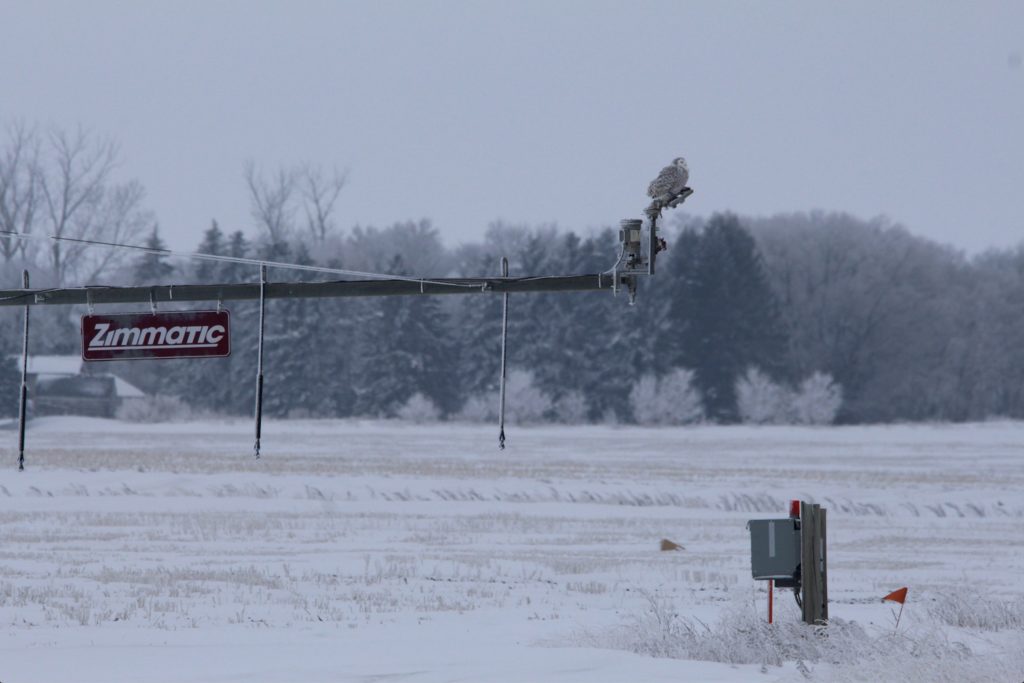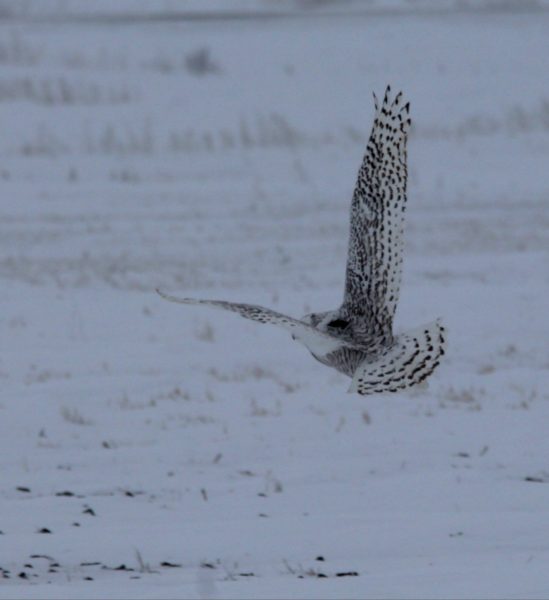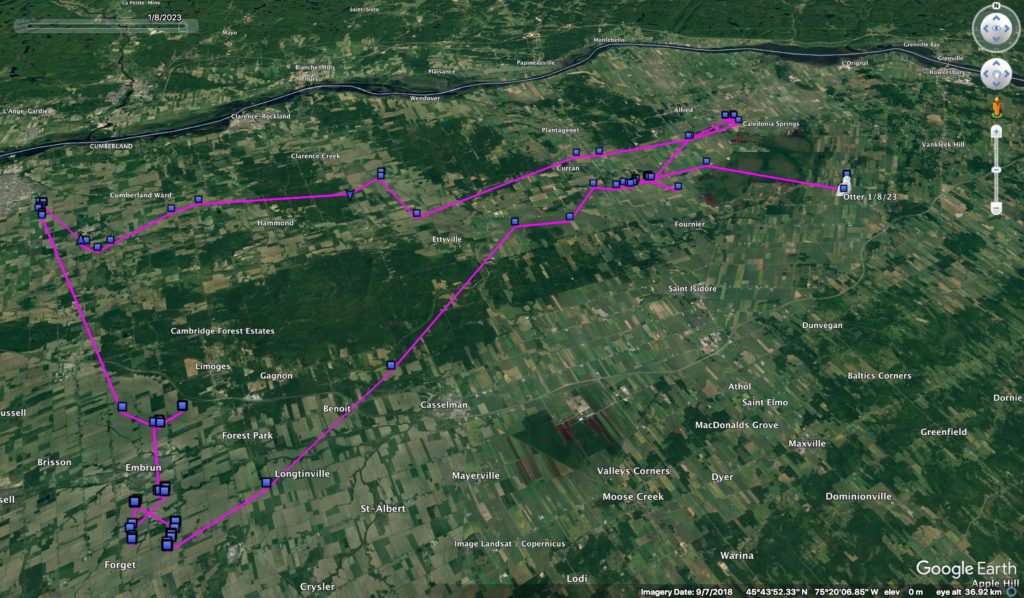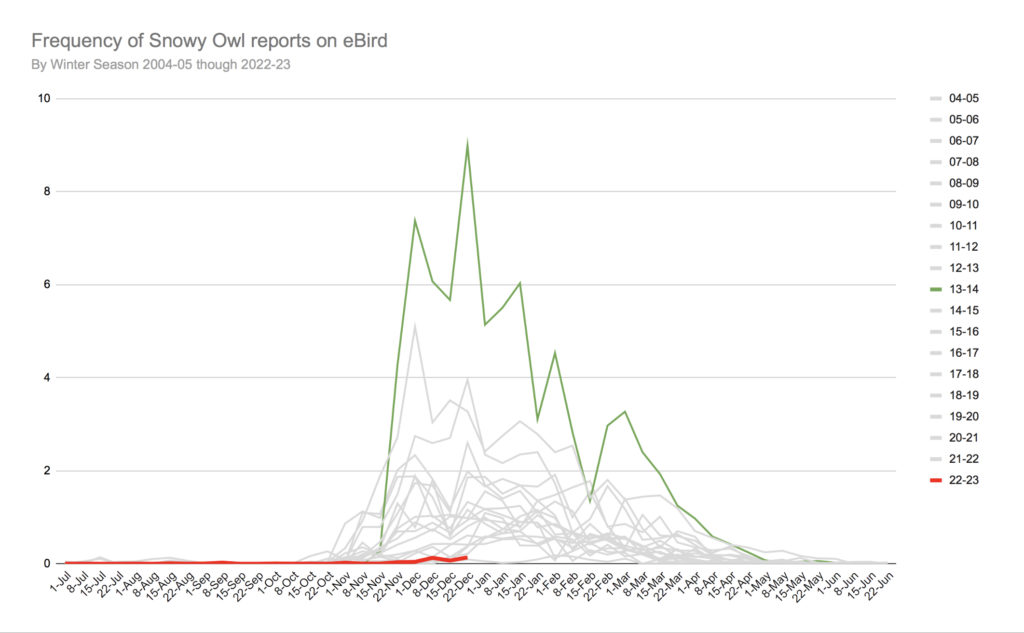
Perched on an irrigation rig, Columbia surveys a wintry landscape near Carman, MB. (©Ken Stewart)
Happy 2023, a bit belatedly — I hope the new year is off to a peaceful start for everyone.

Columbia, off on the hunt. (©Ken Stewart)
Columbia certainly seems to have found her spot, and every check-in shows her using a fairly small 11 sq. km (4.25 sq. mile) area of farmland southeast of Carman, MB. That’s where Ken Stewart, an amateur wildlife photographer, encountered Columbia on Jan. 1 and was able to get a series of photos of her, which he was kind enough to share with us. Her transmitter is riding well and staying above her back feathers, which explains the good solar charge it’s maintaining despite what the photos suggest is some gloomy winter weather.

Round and round he goes: Otter’s route over the past 10 days. (©Project SNOWstorm and Google Earth)
Otter hasn’t been in a mood to settle down; he’s been roaming back and forth across the farmland east of Ottawa and south of the Ottawa River since arriving there in mid-December, and doesn’t seem inclined to stop. As of Jan. 8 he was near the village of St-Bernardin, ON, but he’d flown some 52 km (32 miles) in the previous two days, and I suspect he’ll keep wandering.
We’ve mentioned here before how remarkably slow this winter is compared with most recent seasons. Last Friday, during our weekly SNOWstorm team Zoom meeting, Norman Smith in Massachusetts reported that only three snowies have been seen at Logan Airport in Boston, where he traps and relocates owls, a very low number for early January. (By contrast, during the big 2013-14 irruption Norman caught and moved more than 150 owls at Logan.) A local Massachusetts Christmas Bird Count recorded just one, a new low record, Norman told us.
Drew Weber, whose day job is running the Merlin project at the Cornell Lab of Ornithology, emailed me shortly after the meeting with a striking visual that shows how unusual this winter is. Drew took eBird data for the past 19 winters, including this one thus far, and plotted snowy owl reports in a graph, shown below. He highlighted the 2013-14 irruption (green), which is obviously a huge outlier — many of us suspect that was the largest irruption since at least the 1920s.

How slow is this winter? The 2013-14 irruption is in green, this winter in red. (eBird, Cornell Lab of Ornithology)
But in red, you can see that this winter is a virtual flat-liner so far. Why? It could be a number of reasons. We know that, with the exception of the tip of Ellsemere Island in the Canadian Arctic, there were no known concentrations of nesting snowy owls in Canada last summer, unlike the productive breeding season in 2021. In Utqiagvik (formerly Barrow), Alaska, Denver Holt’s Owl Research Institute team found more than 50 snowy owls on territory last summer, but located just a single nest; Denver isn’t sure why the rest didn’t breed.
There’s also some concern about the impact that highly pathogenic avian influenza (HPAI), which exploded across North America last winter, has had on snowy owls. We know that quite a few snowy owls were confirmed dead from HPAI in New England and elsewhere; Denver has said that at least one was confirmed this year in Utqiagvik. We apparently lost several of our owls last spring, including Bleuet, who apparently died on her way north through southern Québec in mid-April, and possibly our old veteran Stella, whose transmitter went stationary and intermittent in central Saskatchewan in late spring. In neither case were we able to recover the owls and determine a cause.
That said, we shouldn’t lose sight of the fact that extremely low winters like this do happen. Look more closely at that graph showing the past 19 winter seasons, and you’ll see that there was another year (in gray, at the bottom) just as poor as this one has been so far. That was the winter of 2010-11, and while there were relatively few eBirders in those days, compared with now, the frequency-of-sighting stats here are corrected for effort and should be comparable between the years. So a winter as poor as this one was followed, two years later, by the biggest irruption in generations. That’s a hopeful coda for this discussion.


9 Comments on “How Does This Winter Stack Up?”
I am smiling, thinking that you and the other PS team members are getting a rest and doing other things. Thanks for the update and the historical perspective, Scott!
No rest for the wicked, Julie! We’ve been busy, and in fact we’ll have some exciting news in the next few days once one of our teams gets back from the field. (Just to whet your curiosity…)
Are you aware a female Snowy Owl has been hanging out on rooftops in the Los Angeles area for approximately four weeks causing a stir in the area?
Yes, in fact I mentioned the Orange Co. snowy in our previous blog post. From what I’ve been able to tell from the media coverage and birding listserves, the crowds have been fairly respectful and the owl appears to be doing well thus far. FYI, the Sea and Sage Audubon chapter will be hosting Denver Holt of the Owl Research Institute in MT, who has been studying breeding snowy owls for 30 years in Alaska, for an in-person and Zoom presentation at 7 p.m. PST Jan. 19; details at https://wp.seaandsageaudubon.org/home-sas/whats-new/#header.
I’m from Michigan and I wonder if your only using data from ebird? Here, it seems we have a lot of people spotting them, but not reporting them on ebird as to not “tell” people where they are. As an example, there were 12 snowy owls spotted in Tuscola county 4 days ago by one viewer in one day. There is a nice fb group here in Michigan that has had numerous people sharing sitings too. Thank you for all your hard work, as an amateur birder I’ve just started getting the hang of finding them.
It’s true that eBird doesn’t get every sighting and report, but there are too many local FB and other social media groups for us to monitor, so eBird provides at least a good high-level picture of what’s going on in any given year.
Thanks for the update Scott, sorry to hear about Stella and Bleuet. It has been quiet in our neck of the woods as well…I like the idea of another irruption in the next few years!
I still remember that winter 2010-11 well for its lack of snowy owls. I didn’t recall seeing any in Ottawa, usually a good place to see snowy owls in the winter and only remember the one owl on Amherst Island.
Here in Ontario, this winter is quite slow but in Wolfe Island we saw 14 snows while in Amherst island only 1